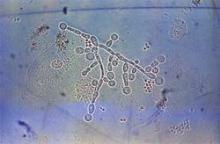DENVER – Candida africana, a species previously unreported in the United States, has been isolated from three women from North Carolina and one from Virginia.
Identified ultimately by sequencing, the organism was first isolated from the Virginia woman’s urine, and then, over the course of a few months, from endometrial biopsy samples from one of the North Carolina women, and vaginal discharge swabs from the two others. The women were aged 15-35 years; one may have been an immigrant. None tested positive for C. albicans.
The good news is that the isolates were susceptible to standard azole therapy and other treatments. "It’s a little bit different from C. albicans because it becomes resistant faster, but [intravaginal] fluconazole should work just fine for" yeast infections, said lead investigator Kevin Hazen, Ph.D., director of clinical microbiology at the Duke University Health System in Durham, N.C.
Even so, "you want to tell your laboratory to be on the lookout for this organism. We need to get much better information about how prevalent it is in the United States, because with that information we can investigate why this supposedly low pathogenic organism is out-competing albicans in [some] women and causing disease. We don’t know why these specific women are getting it or how significant it is in terms of causing recurrent yeast infections or subsequent disease," he said at the annual Interscience Conference on Antimicrobial Agents and Chemotherapy.
C. africana may well be endemic in the United States at this point, but it has been unrecognized until now because laboratories have reported it simply as "yeast, not Candida albicans."
"This organism kind of looks like albicans "on wet mount and is also germ tube positive. "Most labs will stop testing at that point," Dr. Hazen said.
But unlike C. albicans, C. africana doesn’t produce chlamydospores, doesn’t grow at 42° C, tests negative for L-proline aminopeptidase activity, and grows in rough colonies on bird seed agar, instead of smooth ones.
C. africana was first isolated on vaginal swabs from women in Madagascar and Angola and described in 1995; it’s since been isolated in Europe, Japan, Chile, and Saudi Arabia, almost exclusively from the female genitourinary tract, but on blood culture in at least one case.
Dr. Hazen said he has no disclosures.



